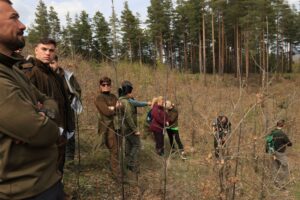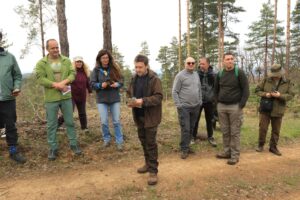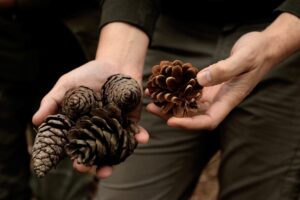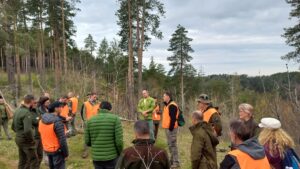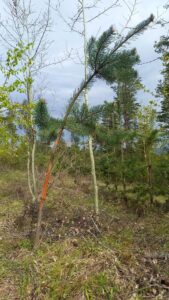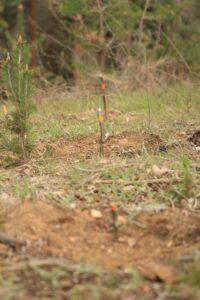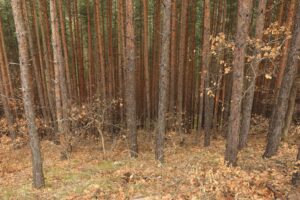WWF-Bulgaria and the Southwestern State Forest Enterprise (SWSFE) organized a study trip on the topic of “Transformation of Forest Plantations” on the territories of the forest enterprises of Ivaylovgrad, Krumovgrad and Blagoevgrad from 14 to 16 April, which brought together forestry experts from Bulgaria, Slovakia and Hungary. The participants exchanged experiences on various practices applied in forests, subject to transformation.
The main topic with examples for discussion during the study tour was the transformations in Scots pine (Pinus sylvestris) cultures. Once massively afforested, in a wide variety of conditions and altitudes, today they are found all over the country and many of them are rapidly changing under the pressure of climate change. In the visited Scots pine forests, almost no new afforestation is taking place, but in many places the results of untimely silvicultural activities are visible, which, in combination with climate change, leads to drying out stands.
“The feedback from WWF followers – people outside the expert circles, who visit the forests for work and pleasure, shows that they are worried about the type of massively drying forests, because they do not have a thorough explanation for what is happening. Therefore, it is important to explain them how forests are transformed and what is the role of foresters,” recalls Vladimir Ivanov, WWF, communicator for the project “Climate-Smart Forest Management in Central and Eastern Europe”.
The other type of transformation that was presented on the territory of the Krumovgrad State Forest Unit was of coppice oak forests into seed forests. Experimental types of felling and afforestation are being carried out in the visited forests to support the development of seed regeneration, which is more sustainable to the changes in the climate.
“In our country, there are three types of transformations, and we are demonstrating the first two: transformation of artificially created cultures from coniferous to local, broad-leaved vegetation and of coppice forests to seed forests. The third type is a transformation of the structure – forests with diverse age structure” shared Assoc. Prof. Dr. Neno Aleksandrov from the Forestry University, participant and lecturer at the meeting.
Main conclusions
Representatives of WWF forest teams from the three Eastern European countries, together with lecturers from the Forest University and experts from the State Forest Enterprises, the Ministry of Agriculture (MAF) and the Executive Forestry Agency (EFA), visited numerous sites where the forest has been changed by a combination of natural disturbances and long-standing forestry practices. The exchange between the participants confirmed several main conclusions for our country:
Despite the changes and gaps over time, forestry in Bulgaria has managed to create a sustainable and diverse forest that is developing successfully and, with properly balanced management, has the potential to maintain both its economic and ecosystem functions. This, unfortunately, is not the reality in many other European countries.
We have a lot of diverse experience, as well as an up-to-date strategy for directing the restoration of the numerous terrains where pine crops are changing with varying success because of rising temperatures, heavy snowfalls, forest fires and many other natural disturbances. However, the Forest Enterprises need to have the freedom and means to react beyond business priorities to ensure the sustainable development of forests.
The delayed carrying out of early-felling in artificially created forest cultures often leads to these forests being more susceptible to natural disturbances. And the lack of such felling is caused by insufficient funding and a shrinking wood market. Considering that, there is a need to diversify the income of forestry and hunting units, which currently rely mostly on income from logging. One option is an evaluation of the forest ecosystem services. Currently there is no payment mechanisms for them in Bulgaria. Payments for ecosystem services are a tool with great potential for species conservation and the implementation of practices that will not be solely business-oriented, to provide long-term water, clean air and rich biodiversity from sustainably managed forests.
Pinus brutia
A different experience for the participants, compared to the visits to the Forestry Units, was the visit to the “Dupkata” Protected Area near Ivaylovgrad. On its small territory of 6.5 ha, it shelters 14 species of orchids and is one of the few places where the Pinus brutia, typical of a warmer, Mediterranean climate, has been proven to have migrated to Bulgaria. To ensure effective protection of the rich biodiversity of the “Dupkata”, WWF is taking steps to increase the territory of the protected area.
The Pinus brutia itself is of interest to the participants because it is one of the species with which experimental afforestation is being carried out within the framework of the project, on the territory of the South-Southern Bulgaria.
What is important to know about forests in transformation?
Forest stands are changing and this is normal. The combination of climate change, species composition, economic needs and other factors shape the change. The role of foresters is to guide and plan it in the long term so that the forest develops sustainably and can simultaneously provide both an economic resource – wood, and clean water, air and biodiversity.
It is important to have a bigger diversity of tree species in forests. Therefore, the transformation of forests is directed and accelerated by people so that mass pine plantations are replaced by mixed forests of coniferous and deciduous species, which are not equally damaged by extreme climate changes or pathogens (fungi), or insects.
However, short-term changes caused by climate change and secondary causes such as various pathogens are worrying. Over the last 10-15 years, their frequency and strength have increased. This is a major challenge for forestry and in general for people who rely on the forest. We need to be faster, more flexible in growing forests, and often there are no resources for this, there is no such experience – the changes are quite recent. Forestry in our country depends mostly on the market, some forestry enterprises have mainly Scots pine, and at the same time there is currently no easy realization on the Bulgarian market for it. This, combined with a lack of labor and equipment, makes the task difficult.
However, Scots pine plantations are not “condemned” and not everywhere they need to be transformed. Some are in an optimal environment in terms of altitude (about 900-1000 m above sea level) and climatic conditions. These forests develop well without serious human intervention, naturally mixing with other species. However, we need to be more active in areas with low altitudes and in those with very serious droughts combined with high temperatures, because they are more vulnerable to climate change.
However, there are also a lot of affected areas, where urgent measures are needed to be implemented. The forest is sustainable to a certain limit and if exceeded, the trees begin to dry out, fall, and secondary factors appear – pests – insects, fungi. As is the case, for example, in recent years with the forests in the Hissar region.
Pine cultures are of the first class of fire hazard. When the forest dries out, it is even more vulnerable. We already have huge areas of such stands affected by fires. This has also happened in the Hissar region, mentioned above. In these places, we must pay special attention if we want to preserve the forest with the benefits it brings us.
Therefore, the concept of Climate Smart Forestry is increasingly necessary in forestry – long-term preservation and development of the forest in the conditions of a changing climate and at the same time ensuring its economic potential – the ability to produce quality wood.
Adaptation to climate change and resilience to natural disturbances of these vulnerable Scots pine cultures is also a priority of the project “Climate-Smart Forest Management in Central and Eastern Europe” LIFE 19/CCA/SK/001276, co-financed by the EU LIFE programme, under which the study tour was organised. Its main objective is to gradually transform these forests into ones with a diverse species and age structure by stimulating the development of natural broadleaf vegetation, which will also increase their overall resilience and health.


